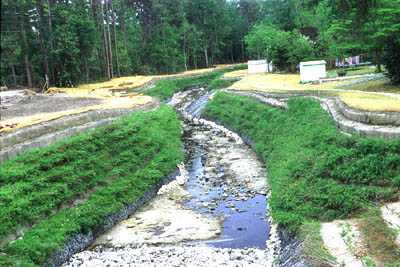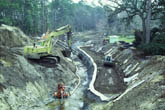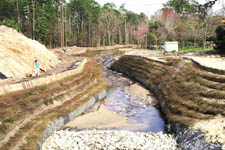Robbin B. Sotir & Associates, Inc.
Case Study: Long Leaf
Location: Wilmington, North Carolina
Client: City of Wilmington
Objectives: Improve flood control, stabilize streambanks, enhance aesthetic, riparian and aquatic habitat within an urban watershed. Develop a cost effective low long term maintenance project.

Nature of Firm's Resonsibility
 Long Leaf Creek is located within an urbanized watershed along coastal North Carolina. The specific stream
reach addressed in this project is located in a residential neighborhood subdivision. It is a highly sensitive project
with a variety of multi-objective goals specific to its location and function in the watershed. Due to the continued
development of the watershed,and specifically a new mall and widened road system immediately up stream, the residents
saw their creek deepen and widen, a result of increased runoff and high concentration events (hurricanes). Properties
were experiencing flooding, bank failures and erosion. Additionally, loss of aesthetic values, riparian corridor vegetation,
aquatic and terrestrial habitat and degradation of water quality were issues that needed to be addressed.
Long Leaf Creek is located within an urbanized watershed along coastal North Carolina. The specific stream
reach addressed in this project is located in a residential neighborhood subdivision. It is a highly sensitive project
with a variety of multi-objective goals specific to its location and function in the watershed. Due to the continued
development of the watershed,and specifically a new mall and widened road system immediately up stream, the residents
saw their creek deepen and widen, a result of increased runoff and high concentration events (hurricanes). Properties
were experiencing flooding, bank failures and erosion. Additionally, loss of aesthetic values, riparian corridor vegetation,
aquatic and terrestrial habitat and degradation of water quality were issues that needed to be addressed.
Due to the need for increased stormwater capacity and hydraulic efficiency requirements, the City of Wilmington undertook a stream reconstruction, restoration and stabilization project in this reach. Meetings were held with the residents and permitting agencies to ensure all requirements were understood and met.
Robbin B. Sotir & Associates, Inc., serving as the soil bioengineering consultant to the Kimley-Horn's interdisciplinary team, worked closely with the geotechnical design, and the hydrologic/hydraulic efficiencies of a soil bioengineering solution to address the desired goals and critical engineering, environmental and aesthetic issues.
Alternatives were compared with the critical issues, which included such items as: stop erosion and stabilize banks; safer and healthier environment; flood control; timely project completion; environmental and aesthetic improvement; minimize property loss; hydraulic efficiency; and cost feasibility.
 After an initial investigation, an alternative analysis was produced in the summer of 1997. This alternative
analysis explored numerous approaches to address each of the project goals with cost and risk factors assigned
to each alternative. Alternatives such as box culvert, 3:1 grassed slopes, 2:1 riprap rock, 2:1 concrete lining,
and soil bioengineering slope systems were considered. The City, with input from the residents and permitting authorities,
selected the soil bioengineering approach and commissioned the design team to produce plan and specification documents,
including construction cost estimates. Pre-bid, pre-construction and permit application services were provided to support
the project. The construction of the project was completed in April of 1999.
After an initial investigation, an alternative analysis was produced in the summer of 1997. This alternative
analysis explored numerous approaches to address each of the project goals with cost and risk factors assigned
to each alternative. Alternatives such as box culvert, 3:1 grassed slopes, 2:1 riprap rock, 2:1 concrete lining,
and soil bioengineering slope systems were considered. The City, with input from the residents and permitting authorities,
selected the soil bioengineering approach and commissioned the design team to produce plan and specification documents,
including construction cost estimates. Pre-bid, pre-construction and permit application services were provided to support
the project. The construction of the project was completed in April of 1999.
The project was designed for the 100 year event. Hurricane Dennis produced an estimated 500 year event coupled with a long duration flow in the channel. While no flooding occurred, some damage was caused in the steepest upper reach of the channel. This was repaired in the winter of 1999 at a cost of 7% of the orignal construction cost. The project has performed well and the City is comfortable with the existing design and performance.
3602 Ernest W. Barrett Parkway
Marietta, Georgia 30064-2732
Phone: 770-424-0719
sotir@sotir.com
©2001 Robbin B. Sotir & Asociates, Inc.